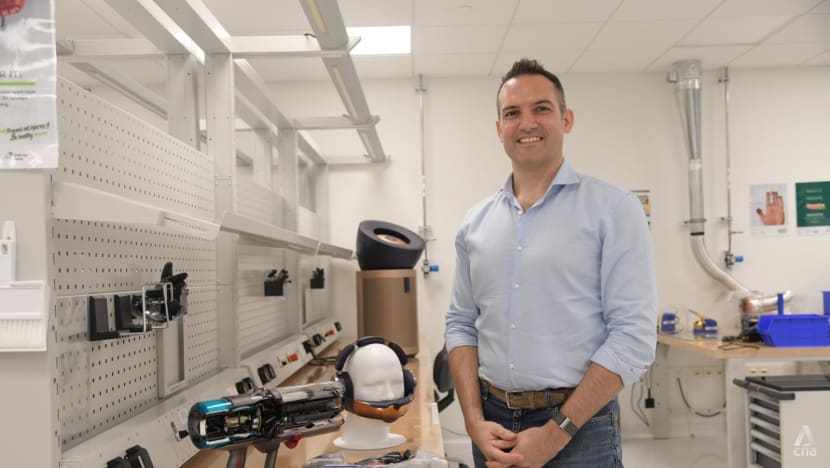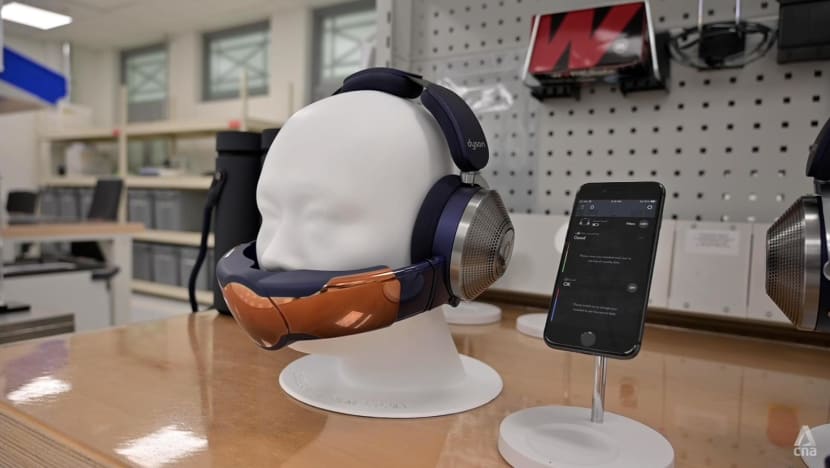'Like watching your own baby being born': Meet the Singapore engineers behind Dyson products
How do Dyson engineers bring an idea from conceptualisation to production? And how are its Singapore engineers involved in the process? CNA finds out.

Dyson's senior electronics manager Brian Hu and product owner Loo Wan Shan. (Photo: CNA/Raydza Rahman)
SINGAPORE: From bagless and cordless vacuum cleaners to bladeless fans, Dyson wants to make daily chores and routine tasks easier.
But bringing ideas from conceptualisation to production typically takes years, with engineers making changes to prototype after prototype.
Dyson’s bagless vacuum cleaner, for example, took no fewer than 5,127 prototypes over five years. The company’s foray into beauty products with its hair dryer involved 600 prototypes across four years.
“Usually, it’s a long process,” Mr Brian Hu, a senior electronics manager at Dyson Singapore, told CNA.
The 39-year-old has designed and developed electronics hardware for a range of Dyson products, such as the bladeless fan and cordless vacuum, over the past 12 years.
The latest project that Mr Hu, who leads a team of 36 engineers in Singapore and Malaysia, spent a year working on is the Big+Quiet air purifier, one of six new products Dyson launched this month.
Mr Hu and his team worked on modifying the motor driver circuit to reduce the noise that typically comes with bigger air purifiers on the market.
The engineers also had to think about how “to make the invisible visible”, so as to allow users to monitor indoor air quality through an LCD screen or the Dyson app.
“We have to utilise many sensor chips to capture (data about the particles in the air) and make sure that is processed correctly, pushed into the cloud and displayed,” Mr Hu added.
This has to be done in coordination with other engineering teams overlooking aspects such as software and technology development – most of which were located in different time zones.
But the satisfaction of overcoming challenges is also immense.
“It’s like watching your own baby being born,” he said with a laugh.

For Ms Loo Wan Shan, who joined Dyson in 2021, the past one-and-a-half years have been a challenging yet fulfilling journey in being part of the team behind the 360 Vis Nav robot vacuum.
Dyson already has several robot vacuums to its name, but this latest offering is billed as its most powerful yet, with the ability to generate maps of "dust hotspots" around the house.
As a product owner in the robotics and intelligent machines team, Ms Loo was among the first to give the robot a run at home.
“What I do as a product owner is to work with the teams, such as global mapping and planning, to focus on specific areas of the robot vacuum that we are building … and ensure that we are building the right things (for the) desired user experience that we want,” said the 37-year-old Singaporean.
“So I'll test a robot at home whenever (there are) new features that the team has built. If it doesn't work, then I’ll feedback to the teams.”

“SINGAPORE IS KEY”
The work of Mr Hu and Ms Loo underscores the role of Singapore in Dyson’s ambitions to double its product portfolio and expand beyond home innovations by 2025.
“Singapore is key to Dyson’s success,” the company’s chief technology officer John Churchill told CNA in an interview last month.
The technology firm, founded by British billionaire James Dyson and best known for its vacuum cleaners, has been in Singapore for more than a decade, with the opening of its first office at Science Park in 2007.
Today, Singapore serves as Dyson’s global head office, as well as a hub for the company’s research, engineering, advanced manufacturing and supply chain operations.
Singapore is where the firm’s patented digital motors are made, with one such motor rolling off the manufacturing line in Jurong every two seconds.
By 2025, next-generation batteries will also be produced in a new high-tech plant located in Tuas.

Dyson currently employs about 1,400 people in Singapore, of which 560 are engineers and scientists.
The company has said it intends to hire another 250 engineers and scientists here, as it pushes deeper into new technologies such as robotics, machine learning and artificial intelligence.
Mr Churchill confirms that hiring is underway.
“The vision for us is to continue to be different (by) going into new categories … and make our products even more sophisticated when it comes to intelligence,” he said.
“That’s why we need robotics engineers and software engineers in order to define new future problems and come up with amazing solutions.”
Mr Churchill also spoke about the Dyson Zone, noise-cancelling headphones that double up as a wearable air purifier. The product – some have called it radical, others bizarre – marks Dyson’s first foray into the wearable and audio engineering markets.
Part of the development for the Dyson Zone was carried out in Singapore.
Mr Hu describes the Zone's design process as “very complicated”, having to fit high-speed motor compressors into each side of the headphones without compromising sound quality.
Engineers also had to be creative in finding space to fit in different chips to power up Bluetooth, audio processing and communication functions.

COMING UP: ROBOTS?
Dyson's bases in Asia include a development centre in Johor Bahru, which has grown from a small cluster of labs to a 50,000 sq m facility housing more than 1,000 employees. The centre focuses on the development of floor care and air purifying products.
Dyson also plans to ramp up its presence in the Philippines, with a new technology facility worth £166 million (US$207 million).
The Singapore base is an “incubator” where confidential investments and research into new technologies take place, said Mr Churchill.
CNA caught a glimpse of this research during a tour of Dyson’s global headquarters at the St James Power Station last month.
The four-storey building is home to more than a dozen labs, ranging from robotics, rapid prototyping to other research. In one of them, where access is highly restricted, a robotics arm was seen picking up different household items from soft toys to cups.
This robotics arm first appeared in a video released by Dyson last May, which signalled the company’s intention to move away from robotic floor-based vacuums and into developing autonomous robots capable of household chores.
Currently, robots still struggle to replicate actions such as grasping fragile objects. Engineers are hoping to crack that with machine learning.

Asked how this new product could take shape, Mr Churchill declined to share details and would only say that Dyson has been “very open-minded” with its investments.
“Sometimes we invest with breadth in terms of the themes that we think will be important in the future and other times when we are more confident about a product offering.”
Ultimately, its engineers are focused on “finding even more efficient ways of doing a task than a human”, he said.
















